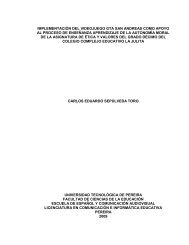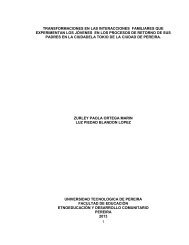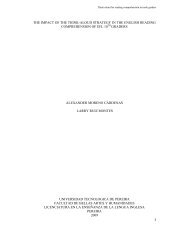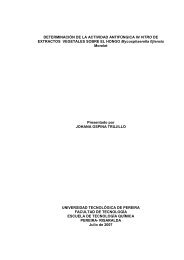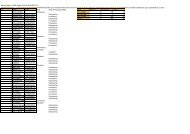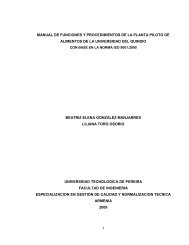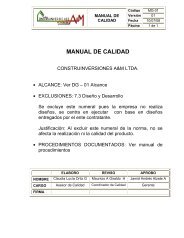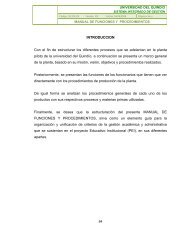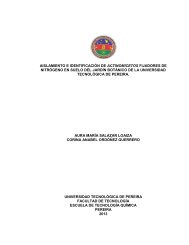- Page 1:
Máquinas de corriente alterna Luis
- Page 4 and 5:
Este libro está hecho con ayuda de
- Page 7 and 8:
Índice general 1. Ecuaciones 1 1.1
- Page 9 and 10:
Capítulo 1 Ecuaciones 1.1. Configu
- Page 11 and 12:
1.2. Aproximación para el caso de
- Page 13 and 14:
1.3. Campos magnéticos en las máq
- Page 15 and 16:
1.3. Campos magnéticos en las máq
- Page 17 and 18:
1.3. Campos magnéticos en las máq
- Page 19 and 20: 1.3. Campos magnéticos en las máq
- Page 21 and 22: 1.4. Máquina bifásica de corrient
- Page 23 and 24: 1.4. Máquina bifásica de corrient
- Page 25 and 26: 1.4. Máquina bifásica de corrient
- Page 27 and 28: 1.4. Máquina bifásica de corrient
- Page 29 and 30: 1.4. Máquina bifásica de corrient
- Page 31 and 32: 1.5. Ecuaciones eléctricas de equi
- Page 33 and 34: 1.5. Ecuaciones eléctricas de equi
- Page 35 and 36: 1.6. Ecuación mecánica de equilib
- Page 37 and 38: 1.6. Ecuación mecánica de equilib
- Page 39 and 40: 1.7. Solución de las ecuaciones ge
- Page 41 and 42: 1.8. Transformación Θ 0 33 [ ] [
- Page 43 and 44: 1.8. Transformación Θ 0 35 Premul
- Page 45 and 46: 1.8. Transformación Θ 0 37 Observ
- Page 47 and 48: 1.9. Transformación de tres ejes a
- Page 49 and 50: 1.9. Transformación de tres ejes a
- Page 51 and 52: 1.9. Transformación de tres ejes a
- Page 53 and 54: 1.9. Transformación de tres ejes a
- Page 55 and 56: 1.10. Componentes simétricas en la
- Page 57 and 58: 1.10. Componentes simétricas en la
- Page 59 and 60: 1.10. Componentes simétricas en la
- Page 61 and 62: 1.10. Componentes simétricas en la
- Page 63 and 64: 1.10. Componentes simétricas en la
- Page 65 and 66: 1.10. Componentes simétricas en la
- Page 67 and 68: • • • • • • • • 1.1
- Page 69: 1.10. Componentes simétricas en la
- Page 73 and 74: 1.10. Componentes simétricas en la
- Page 75 and 76: 1.10. Componentes simétricas en la
- Page 77 and 78: 1.10. Componentes simétricas en la
- Page 79 and 80: 1.10. Componentes simétricas en la
- Page 81 and 82: 1.10. Componentes simétricas en la
- Page 83 and 84: 1.10. Componentes simétricas en la
- Page 85 and 86: 1.10. Componentes simétricas en la
- Page 87 and 88: 1.10. Componentes simétricas en la
- Page 89 and 90: 1.10. Componentes simétricas en la
- Page 91: 1.10. Componentes simétricas en la
- Page 94 and 95: 86 Capítulo 2. La máquina sincró
- Page 96 and 97: 88 Capítulo 2. La máquina sincró
- Page 98 and 99: √ 3 2 Vsen nθ 0(0) − E f = (L
- Page 100 and 101: 92 Capítulo 2. La máquina sincró
- Page 102 and 103: 94 Capítulo 2. La máquina sincró
- Page 104 and 105: 96 Capítulo 2. La máquina sincró
- Page 106 and 107: 98 Capítulo 2. La máquina sincró
- Page 108 and 109: 100 Capítulo 2. La máquina sincr
- Page 110 and 111: 102 Capítulo 2. La máquina sincr
- Page 112 and 113: 104 Capítulo 2. La máquina sincr
- Page 114 and 115: 106 Capítulo 2. La máquina sincr
- Page 116 and 117: 108 Capítulo 2. La máquina sincr
- Page 118 and 119: 110 Capítulo 2. La máquina sincr
- Page 120 and 121:
112 Capítulo 2. La máquina sincr
- Page 122 and 123:
114 Capítulo 2. La máquina sincr
- Page 124 and 125:
116 Capítulo 2. La máquina sincr
- Page 126 and 127:
118 Capítulo 2. La máquina sincr
- Page 128 and 129:
120 Capítulo 2. La máquina sincr
- Page 130 and 131:
122 Capítulo 2. La máquina sincr
- Page 132 and 133:
124 Capítulo 2. La máquina sincr
- Page 134 and 135:
126 Capítulo 2. La máquina sincr
- Page 136 and 137:
128 Capítulo 2. La máquina sincr
- Page 138 and 139:
130 Capítulo 2. La máquina sincr
- Page 140 and 141:
132 Capítulo 2. La máquina sincr
- Page 142 and 143:
× × × 134 Capítulo 2. La máqui
- Page 144 and 145:
136 Capítulo 2. La máquina sincr
- Page 146 and 147:
138 Capítulo 2. La máquina sincr
- Page 148 and 149:
140 Capítulo 2. La máquina sincr
- Page 150 and 151:
142 Capítulo 2. La máquina sincr
- Page 152 and 153:
144 Capítulo 2. La máquina sincr
- Page 154 and 155:
146 Capítulo 2. La máquina sincr
- Page 156 and 157:
148 Capítulo 2. La máquina sincr
- Page 158 and 159:
150 Capítulo 2. La máquina sincr
- Page 160 and 161:
152 Capítulo 2. La máquina sincr
- Page 162 and 163:
154 Capítulo 2. La máquina sincr
- Page 164 and 165:
156 Capítulo 2. La máquina sincr
- Page 166 and 167:
158 Capítulo 2. La máquina sincr
- Page 168 and 169:
160 Capítulo 2. La máquina sincr
- Page 170 and 171:
162 Capítulo 2. La máquina sincr
- Page 172 and 173:
164 Capítulo 2. La máquina sincr
- Page 174 and 175:
166 Capítulo 2. La máquina sincr
- Page 176 and 177:
168 Capítulo 2. La máquina sincr
- Page 178 and 179:
170 Capítulo 2. La máquina sincr
- Page 180 and 181:
172 Capítulo 2. La máquina sincr
- Page 182 and 183:
174 Capítulo 2. La máquina sincr
- Page 184 and 185:
176 Capítulo 2. La máquina sincr
- Page 186 and 187:
178 Capítulo 2. La máquina sincr
- Page 188 and 189:
180 Capítulo 2. La máquina sincr
- Page 190 and 191:
182 Capítulo 2. La máquina sincr
- Page 192 and 193:
184 Capítulo 2. La máquina sincr
- Page 195 and 196:
Capítulo 3 La máquina de inducci
- Page 197 and 198:
3.2. Modelo circuital 189 2 ηρθ
- Page 199 and 200:
3.3. La máquina de inducción con
- Page 201 and 202:
3.3. La máquina de inducción con
- Page 203 and 204:
3.3. La máquina de inducción con
- Page 205 and 206:
3.3. La máquina de inducción con
- Page 207 and 208:
3.3. La máquina de inducción con
- Page 209 and 210:
3.4. Caso de voltajes balanceados 2
- Page 211 and 212:
3.4. Caso de voltajes balanceados 2
- Page 213 and 214:
• 3.4. Caso de voltajes balancead
- Page 215 and 216:
3.5. Determinación del torque medi
- Page 217 and 218:
3.6. La máquina de inducción mono
- Page 219 and 220:
3.6. La máquina de inducción mono
- Page 221 and 222:
3.6. La máquina de inducción mono
- Page 223 and 224:
3.7. Transitorios en la máquinas d
- Page 225 and 226:
3.7. Transitorios en la máquinas d
- Page 227 and 228:
3.7. Transitorios en la máquinas d
- Page 229 and 230:
3.7. Transitorios en la máquinas d
- Page 231 and 232:
3.7. Transitorios en la máquinas d
- Page 233 and 234:
3.7. Transitorios en la máquinas d
- Page 235 and 236:
3.7. Transitorios en la máquinas d
- Page 237 and 238:
3.7. Transitorios en la máquinas d
- Page 239 and 240:
3.7. Transitorios en la máquinas d
- Page 241 and 242:
3.7. Transitorios en la máquinas d
- Page 243 and 244:
3.7. Transitorios en la máquinas d
- Page 245 and 246:
3.7. Transitorios en la máquinas d
- Page 247 and 248:
3.7. Transitorios en la máquinas d
- Page 249 and 250:
3.7. Transitorios en la máquinas d
- Page 251 and 252:
3.7. Transitorios en la máquinas d
- Page 253 and 254:
3.7. Transitorios en la máquinas d
- Page 255 and 256:
3.7. Transitorios en la máquinas d
- Page 257 and 258:
3.7. Transitorios en la máquinas d
- Page 259 and 260:
• • • • • • • • 3.7
- Page 261 and 262:
3.7. Transitorios en la máquinas d
- Page 263 and 264:
3.7. Transitorios en la máquinas d
- Page 265 and 266:
3.7. Transitorios en la máquinas d
- Page 267 and 268:
3.7. Transitorios en la máquinas d
- Page 269 and 270:
3.7. Transitorios en la máquinas d
- Page 271 and 272:
Bibliografía Adkins, Bernand. The




